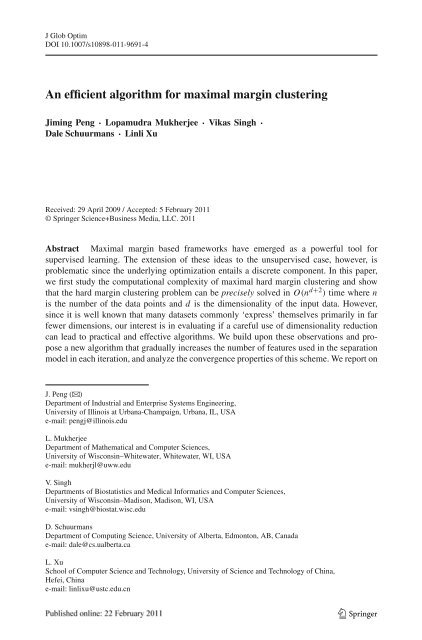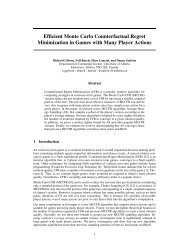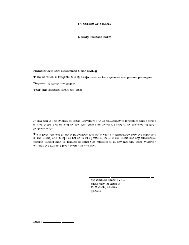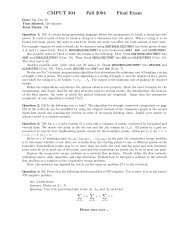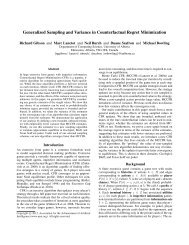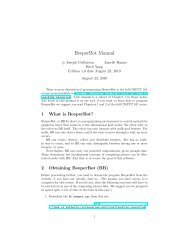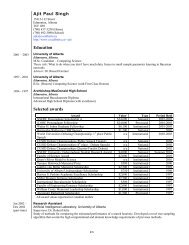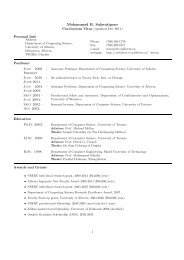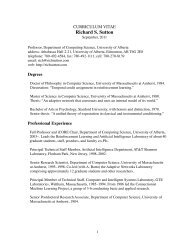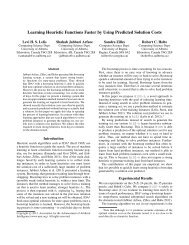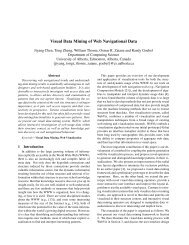An efficient algorithm for maximal margin clustering - ResearchGate
An efficient algorithm for maximal margin clustering - ResearchGate
An efficient algorithm for maximal margin clustering - ResearchGate
You also want an ePaper? Increase the reach of your titles
YUMPU automatically turns print PDFs into web optimized ePapers that Google loves.
J Glob Optim<br />
DOI 10.1007/s10898-011-9691-4<br />
<strong>An</strong> <strong>efficient</strong> <strong>algorithm</strong> <strong>for</strong> <strong>maximal</strong> <strong>margin</strong> <strong>clustering</strong><br />
Jiming Peng · Lopamudra Mukherjee · Vikas Singh ·<br />
Dale Schuurmans · Linli Xu<br />
Received: 29 April 2009 / Accepted: 5 February 2011<br />
© Springer Science+Business Media, LLC. 2011<br />
Abstract Maximal <strong>margin</strong> based frameworks have emerged as a powerful tool <strong>for</strong><br />
supervised learning. The extension of these ideas to the unsupervised case, however, is<br />
problematic since the underlying optimization entails a discrete component. In this paper,<br />
we first study the computational complexity of <strong>maximal</strong> hard <strong>margin</strong> <strong>clustering</strong> and show<br />
that the hard <strong>margin</strong> <strong>clustering</strong> problem can be precisely solved in O(n d+2 ) time where n<br />
is the number of the data points and d is the dimensionality of the input data. However,<br />
since it is well known that many datasets commonly ‘express’ themselves primarily in far<br />
fewer dimensions, our interest is in evaluating if a careful use of dimensionality reduction<br />
can lead to practical and effective <strong>algorithm</strong>s. We build upon these observations and propose<br />
a new <strong>algorithm</strong> that gradually increases the number of features used in the separation<br />
model in each iteration, and analyze the convergence properties of this scheme. We report on<br />
J. Peng (B)<br />
Department of Industrial and Enterprise Systems Engineering,<br />
University of Illinois at Urbana-Champaign, Urbana, IL, USA<br />
e-mail: pengj@illinois.edu<br />
L. Mukherjee<br />
Department of Mathematical and Computer Sciences,<br />
University of Wisconsin–Whitewater, Whitewater, WI, USA<br />
e-mail: mukherjl@uww.edu<br />
V. Singh<br />
Departments of Biostatistics and Medical In<strong>for</strong>matics and Computer Sciences,<br />
University of Wisconsin–Madison, Madison, WI, USA<br />
e-mail: vsingh@biostat.wisc.edu<br />
D. Schuurmans<br />
Department of Computing Science, University of Alberta, Edmonton, AB, Canada<br />
e-mail: dale@cs.ualberta.ca<br />
L. Xu<br />
School of Computer Science and Technology, University of Science and Technology of China,<br />
Hefei, China<br />
e-mail: linlixu@ustc.edu.cn<br />
123
J Glob Optim<br />
promising numerical experiments based on a ‘truncated’ version of this approach. Our experiments<br />
indicate that <strong>for</strong> a variety of datasets, good solutions equivalent to those from other<br />
existing techniques can be obtained in significantly less time.<br />
Keywords<br />
Maximum <strong>margin</strong> · Clustering · Unsupervised · SDP<br />
1 Introduction<br />
The study of <strong>maximal</strong> <strong>margin</strong>-based learning <strong>algorithm</strong>s [1] (or support vector machines)<br />
has become an active area of research in machine learning and data mining over the past<br />
few decades. SVM frameworks have been developed <strong>for</strong> a variety of classification problems<br />
and have been applied in a number of different application domains, see [2]. Inspired<br />
by the success of support vector machines <strong>for</strong> supervised learning, Xu et al. [3] recently<br />
proposed a <strong>maximal</strong> <strong>margin</strong> <strong>clustering</strong> <strong>algorithm</strong> <strong>for</strong> unsupervised learning problems. In<br />
subsequent work, Xu and Schuurmans [4] extended their earlier <strong>for</strong>mulations [3] tothe<br />
semi-supervised multi-class classification setting. Promising experiments on small-scale<br />
datasets were reported in [3,4]. In general, empirical results have demonstrated that <strong>maximal</strong><br />
<strong>margin</strong> <strong>clustering</strong> achieves good quality solutions relative to other popular <strong>algorithm</strong>s.<br />
Un<strong>for</strong>tunately, such experiments have also highlighted a few important limitations [5]. A<br />
major shortcoming as noted in [5] is the running time, which increases very rapidly with the<br />
size of the data—making it practically infeasible <strong>for</strong> use with larger datasets. Addressing this<br />
difficulty is our primary interest in this paper.<br />
1.1 Related work<br />
The idea of separating unlabeled data sets with <strong>maximal</strong> <strong>margin</strong> can be traced back to [6]<br />
where the authors considered semi-supervised or transductive SVMs. Transductive support<br />
vector machines (TSVMs) use unlabeled data to improve the generalization of SVMs. Here,<br />
a large <strong>margin</strong> separating hyperplane is determined using labeled training data. However, as<br />
an extension of the supervised setting, this hyperplane is <strong>for</strong>ced to pass through low density<br />
regions of the unlabeled data. In recent work [7,8], a convex relaxation <strong>for</strong> transductive<br />
SVMs was proposed using spectral transduction to find the subspace of interest as means<br />
of approximating the underlying optimization problem (which will be introduced shortly).<br />
These <strong>algorithm</strong>s essentially follow a mechanism similar to standard SVMs, i.e., they use the<br />
primal-dual structure of convex quadratic optimization problems. Let us discuss the relevant<br />
details of such an approach briefly. Consider the hard <strong>maximal</strong> <strong>margin</strong> <strong>clustering</strong> problem<br />
(without class balance constraints) defined as follows 1 :<br />
min<br />
y i ∈{1,−1}<br />
f(y) = min<br />
w<br />
wT w<br />
s.t. y i (w T v i + b) ≥ 1, i = 1,...,n. (1)<br />
In [3,7], the authors derived the dual of the low-level problem that allowed them to focus<br />
on the following model instead.<br />
1 We note that in [3,4], to accommodate the inseparable case, the authors used the so-called soft SVMs.<br />
However, as we shall discuss later, <strong>for</strong> <strong>clustering</strong> problems, the data set is always separable.<br />
123
J Glob Optim<br />
min<br />
y i ∈{−1,1}<br />
f(y) = max<br />
u<br />
2uT e − u T YMYu<br />
s.t. u ≥ 1, u T y = 0, Y = diag (y), (2)<br />
where M =[m ij ] is the square matrix whose entries are given as m ij = v T i v j . We can see<br />
that problems (1) and(2) are both challenging discrete optimization problems, and it is difficult<br />
to solve them (to optimality) <strong>efficient</strong>ly. A simple analysis shows that the semidefinite<br />
programming (SDP) relaxations of these problems are nontrivial as well. For example, the<br />
SDP relaxation proposed in [3,4] hasO(n 2 ) constraints. There<strong>for</strong>e, the model can only be<br />
applied to data sets of a relatively small size. To address this problem, the authors in [5]proposed<br />
another SDP based approach based on the Lagrangian dual of the problem. While the<br />
approach [5] reduces the complexity of earlier models in [3,4], there is no guarantee that the<br />
optimal solutions from the primal and dual problems are equivalent. Also, the <strong>algorithm</strong> in [5]<br />
is still dependent on the capacity of the underlying SDP solvers. For a given SDP problem of<br />
size n with m constraints, the computational cost at each iteration of interior-point methods<br />
(using the best available SDP solver) is O(n 2 m 2 + mn 3 ) [9]; problems with large-scale data<br />
sets lie much beyond what the fastest solvers [9] available at this time offer. 2 In an ef<strong>for</strong>t to<br />
at least partially mitigate this problem, a strategy of updating u and y in (2) in an iterative<br />
framework was investigated in a recent work [10]. However, the authors reported that the<br />
experimental results from the iterative SVM procedure were unsatisfactory, leading them<br />
to adopt a regression approach. In other words, [10] did not directly address the <strong>maximal</strong><br />
<strong>margin</strong> model [3]; rather, proposed and argued <strong>for</strong> an alternate soft <strong>margin</strong> <strong>for</strong>mulation.<br />
In summary, all existing <strong>algorithm</strong>s <strong>for</strong> <strong>maximal</strong> <strong>margin</strong> <strong>clustering</strong> follow a framework<br />
similar to SVMs <strong>for</strong> supervised learning. This strategy has certain advantages but makes it<br />
difficult to explore (and make use of) the <strong>clustering</strong> specific characteristics in the design of the<br />
<strong>algorithm</strong>. For example, while separability is a major concern in SVMs <strong>for</strong> (semi)supervised<br />
learning, it is not a key issue <strong>for</strong> data <strong>clustering</strong> since any hyperplane in the input space that<br />
passes through the center of a line segment between a point pair in the data set will be able<br />
to “separate” the data set into two subsets. Observe that we avoid asking how “good” the<br />
separation is—instead focus merely on the separability of unlabeled points. The “goodness”<br />
of a separator is a quantity we would like to optimize later. With this in mind, we propose<br />
a new approach <strong>for</strong> the <strong>maximal</strong> <strong>margin</strong> <strong>clustering</strong>. Under mild assumptions, we first show<br />
that the hard <strong>maximal</strong> <strong>margin</strong> <strong>clustering</strong> problem can be solved in O(n d+2 ) time, where n is<br />
the size of the input data set, and d is the dimensionality of the input space. As we will see<br />
shortly, this yields an <strong>efficient</strong> and practical <strong>algorithm</strong> <strong>for</strong> problems involving datasets that<br />
can be characterized in lower dimensional spaces.<br />
The discussion above brings up the issue of a balance between the quality of the solution<br />
and the <strong>algorithm</strong> efficiency. We note that exact <strong>algorithm</strong>s <strong>for</strong> several <strong>clustering</strong> problems like<br />
k-means typically have a very high complexity, but nice approximation <strong>algorithm</strong>s based on<br />
convex relaxation and subspace ideas have been suggested [8,11]. For more recent advances<br />
in optimization <strong>for</strong> <strong>clustering</strong>, we refer to [12–18] and the references therein. Inspired by<br />
these results, we consider how to incorporate feature selection concepts into the optimization<br />
model <strong>for</strong> <strong>maximal</strong> <strong>margin</strong> <strong>clustering</strong>, in an ef<strong>for</strong>t to improve efficiency. For instance,<br />
<strong>for</strong> a given parameter k, we consider the problem of finding the <strong>maximal</strong> <strong>margin</strong> separationbyusingatmostk<br />
features of that instance. It can be verified that as k increases, the<br />
separating <strong>margin</strong> becomes larger. This yields a cascade <strong>for</strong> different choices of k. Bythis<br />
2 Also observe that the number of constraints m (where m = n 2 ) is much larger than the size of the matrix n.<br />
There<strong>for</strong>e, there is a large gap between the complexity of the standard SDP problem (where m
J Glob Optim<br />
logic, the <strong>maximal</strong> <strong>margin</strong> <strong>clustering</strong> with a fixed number of features can also be cast as an<br />
approximate solution to the original <strong>maximal</strong> <strong>margin</strong> <strong>clustering</strong> problem and be used in a<br />
semi-supervised learning setting. Later, we investigate an <strong>algorithm</strong> based on this idea and<br />
analyze its convergence properties.<br />
The rest of the paper is organized as follows. In Sect. 2, we discuss the complexity of<br />
the <strong>maximal</strong> <strong>margin</strong> problem and present an <strong>algorithm</strong>. Then, we analyze how the idea of<br />
<strong>maximal</strong> <strong>margin</strong> separation can be extended to some existing graph-cut models <strong>for</strong> <strong>clustering</strong>.<br />
In Sect. 3, we discuss the <strong>maximal</strong> <strong>margin</strong> <strong>clustering</strong> problem with a fixed number<br />
of features, which can be viewed as a combination of the <strong>maximal</strong> <strong>margin</strong> <strong>clustering</strong> and<br />
feature selection. In Sect. 4, we propose a new successive procedure to approximately solve<br />
the original hard <strong>maximal</strong> <strong>margin</strong> <strong>clustering</strong> problem and study its convergence properties.<br />
We also discuss how to deal with the semi-supervised learning case. Experimental results<br />
based on these ideas are reported in Sect. 5 and we conclude the paper in Sect. 6.<br />
2 Complexity of hard <strong>maximal</strong> <strong>margin</strong> <strong>clustering</strong><br />
In this section, we investigate the complexity of the hard <strong>maximal</strong> <strong>margin</strong> <strong>clustering</strong>. Throughout<br />
the paper, we make the following assumption:<br />
Assumption 1 [General Position] All the points in the input data set V ={v 1 ,v 2 ,...,v n }<br />
are in general position, i.e., any d points in V will define precisely one hyperplane in R d .<br />
We remark that the above assumption is quite reasonable, because if the data set V does<br />
not satisfy the assumption, we may perturb the data set slightly so that the assumption holds.<br />
We can now state the following result.<br />
Theorem 1 Suppose that the input data set satisfies Assumption 1 and (w ∗ ,b ∗ ) is the global<br />
solution to problem (1). Then, there must exist a subset V ∗ ⊂ V with either d or d + 1 points<br />
such that at least one of the following two conditions hold:<br />
(1) The hyperplane defined by the points in V ∗ will create the same separation as the<br />
optimal separating hyperplane.<br />
(2) The optimal separating hyperplane is also the global solution of problem (1) where V<br />
is replaced by V ∗ .<br />
Proof Suppose that (w ∗ ,b ∗ ) is the global solution to problem (1), we can then separate the<br />
data set V into two subsets V 1 and V 2 such that<br />
V 1 ={v ∈ V : (w ∗ ) T v + b ∗ > 0},<br />
V 2 ={v ∈ V : (w ∗ ) T v + b ∗ < 0}. (3)<br />
Further, by the definition of <strong>maximal</strong> <strong>margin</strong>, there exist two subsets Ṽ 1 , Ṽ 2 such that ∀ v 1 ,v 2 :<br />
v 1 ∈ Ṽ 1 ⊂ V 1 ,v 2 ∈ Ṽ 2 ⊂ V 2 ,<br />
(<br />
(w ∗ ) T v 1 + b ∗ =− (w ∗ ) T v 2 + b ∗) = 1. (4)<br />
For a given data set V, let|V| denote the number of points in V. Since all points in V are in<br />
general position, we can claim that<br />
|Ṽ 1 |≤d, |Ṽ 2 |≤d, |Ṽ 1 |+|Ṽ 2 |≥d. (5)<br />
If there exist at least d + 1 points in Ṽ 1 ∪ Ṽ 2 , we may select d + 1 points from Ṽ 1 ∪ Ṽ 2 and<br />
these d + 1 points will define the separating hyperplane (w ∗ ) T v + b ∗ = 0 due to the general<br />
123
J Glob Optim<br />
position assumption. If there exist precisely d points in Ṽ 1 ∪ Ṽ 2 , we can find the <strong>maximal</strong><br />
<strong>margin</strong> separation hyperplane based on these d points. This statement of the theorem follows.<br />
⊓⊔<br />
Based on the above result, we can per<strong>for</strong>m a comprehensive search over all the subsets of<br />
size d and find the global solution of problem (1). Let C(n,d) be the combinatorial function<br />
of selecting d points out of n points in total, ( n<br />
d)<br />
. The <strong>algorithm</strong> above has a running time of<br />
C(n,d + 1)2 d+1 n, i.e., O(n d+2 ).Ifd = 1, the complexity reduces to O(nlog n)—we first<br />
sort the data points, and then find the <strong>maximal</strong> <strong>margin</strong> separation. If d = 2, from relation (5)<br />
we can see that both sets Ṽ 1 and Ṽ 2 have either 1 or 2 points. Suppose that Ṽ 1 contains two<br />
points, then those two points will define the separating hyperplane. If both Ṽ 1 and Ṽ 2 have<br />
only one point, i.e., v 1 ∈ Ṽ 1 ,v 2 ∈ Ṽ 2 , then it is easy to see that the straight line perpendicular<br />
to the segment from v 1 to v 2 which passes through the midpoint (v 1 + v 2 )/2 is the optimal<br />
separating line. There<strong>for</strong>e, we can enumerate all possible point pairs. For every point pair,<br />
we compare the two <strong>margin</strong>s derived by the two separating lines described in our previous<br />
discussion and choose the one with a larger <strong>margin</strong>, which gives a running time of O(n 3 ).<br />
The procedure is quite <strong>efficient</strong> <strong>for</strong> datasets in lower dimensions, though it is still expensive<br />
<strong>for</strong> large values of d. In the next subsection, we briefly remark on the relationship of the <strong>maximal</strong><br />
<strong>margin</strong> model with graph cut based <strong>clustering</strong>. We then discuss in detail how feature<br />
selection combined with the ideas above can be used to approximately solve the <strong>maximal</strong><br />
<strong>margin</strong> <strong>clustering</strong>.<br />
2.1 Connections to graph-cut based <strong>clustering</strong><br />
Graph partitioning based approaches have emerged as powerful tools <strong>for</strong> <strong>clustering</strong> in the last<br />
decade [11,19]. Such techniques have also been found to be extremely useful <strong>for</strong> image segmentation<br />
problems [19]. This popularity has led to investigations into the connection of such<br />
<strong>algorithm</strong>s to other techniques such as kernel k-means [20] and transductive SVMs [6]. Here,<br />
we discuss how the <strong>maximal</strong> <strong>margin</strong> approach <strong>for</strong> unsupervised learning can also be extended<br />
to deal with graph partitioning based <strong>clustering</strong> problems (e.g., normalized cuts [19]). To see<br />
this, we first recall the definition of the normalized cut problem. Let W be the weight matrix<br />
of a graph, and X =[x ij ]∈R n×2 be the assignment matrix and e m be the all 1 vector in R m .<br />
Let us define<br />
F ={X : Xe 2 = e n , x ij ∈{0, 1}}.<br />
Let γ = We n and Ɣ = diag (γ ). The exact model <strong>for</strong> the normalized k-cut problem in [19]<br />
can be rewritten as<br />
If we define<br />
min<br />
X∈F tr(Ɣ−1 W − X(X T ƔX) −1 X T W) (6)<br />
Z = Ɣ 2 1 X(X T ƔX) −1 X T Ɣ 2 1 ,Wγ = Ɣ − 2 1 WƔ<br />
− 2 1 , (7)<br />
then the above model can be equivalently stated as:<br />
min tr(W γ (I − Z)) (8)<br />
Zγ 2 1 1<br />
= γ 2 , tr(Z) = 2, (9)<br />
Z ≥ 0, Z 2 = Z, Z = Z T . (10)<br />
123
J Glob Optim<br />
It has been shown [20,21] that when Ɣ is the identity matrix (or γ = e n )andw ij = vi T v j ,<br />
the above model amounts to the classical k-means <strong>clustering</strong>. There<strong>for</strong>e, we can interpret γ<br />
as a special scaling vector that enables us to normalize and project the input data (derived by<br />
using the singular value decomposition of W γ ) in a suitable subspace. Observe that since 1 is<br />
the largest eigenvalue of W γ and W γ γ 2<br />
1 = γ 2 1 , we can consider the separation based on the<br />
data set projected onto the null space of γ 2 1 , the popular spectral <strong>clustering</strong> indeed utilizes<br />
the first principal component of the projected data matrix to separate the data set. In fact,<br />
in [19], the authors suggested using <strong>maximal</strong> <strong>margin</strong> separation based on the first principal<br />
component of the projected matrix.<br />
3 Maximal <strong>margin</strong> <strong>clustering</strong> with feature selection<br />
In this section, we propose a new optimization model that can be viewed as a combination<br />
of feature selection and <strong>maximal</strong> <strong>margin</strong> <strong>clustering</strong>. For any vector w ∈R d ,letI(w) denote<br />
the number of nonzero elements in w. For a given integer k>0, we consider the following<br />
optimization problem<br />
min<br />
y i ∈{1,−1} f(y) = min wT w<br />
s.t. y i (w T v i + b) ≥ 1, i = 1,...,n;<br />
I(w) ≤ k. (11)<br />
In other words, we impose the condition I(w) ≤ k on the solution of the maximum <strong>margin</strong><br />
<strong>clustering</strong> problem. Since there are in total C(d,k) different index sets of size k <strong>for</strong> a fixed<br />
k, wehave<br />
Theorem 2 Suppose that the input data set satisfies Assumption 1. Then <strong>for</strong> any fixed k,we<br />
can find a global solution to problem (11) in O(C(d,k)n k+2 ) time. Moreover, the objective<br />
value at the optimal solution of problem (11) is a decreasing function of k.<br />
The second conclusion in the above theorem sets up a cascade to approximate the original<br />
<strong>maximal</strong> <strong>margin</strong> <strong>clustering</strong> where k = d. The remaining difficulty is that solving problem<br />
(11) requires O(C(d,k)n k+2 ) time and does not seem to be a very attractive option. To<br />
address this problem, let us recall (1)—it is straight<strong>for</strong>ward to verify that<br />
Theorem 3 Let V ∈R d×n be the data matrix such that each column of V represents a point<br />
in R d . For any unitary matrix U ∈R d×d ,let ¯V = UV be the data matrix after rotation. Then,<br />
the optimal solutions of problem (1) with respect to data matrices V and ¯V have precisely<br />
the same objective value.<br />
The above result gives us a simple and natural strategy to approximate the <strong>maximal</strong> <strong>margin</strong><br />
<strong>clustering</strong> by using the eigenvalues and eigenvectors of matrix V. Let us denote the eigenvalue<br />
decomposition (SVD) of V by<br />
V = U T ΛQ, U ∈R d×d , Λ ∈R d×n , Q ∈R n×n<br />
where U and Q are unitary matrices in suitable space, and<br />
Λ =[diag (λ 1 ,...,λ d ), 0]<br />
where λ 1 ≥ λ 2 ≥···≥λ d are the eigenvalues of V. We can use the product of the first k right<br />
eigenvectors (the first k columns of Q) with the corresponding k largest eigenvalues to project<br />
123
J Glob Optim<br />
Algorithm 1 Maximal Margin Clustering<br />
MaxMarginClustering(V,k)<br />
Input: V ={v i ∈R d : i = 1,...,n};<br />
Output: Cluster label T ;<br />
begin<br />
Compute the projected data set ¯V ={¯v i ∈R k : i = 1,...,n},<br />
Let S ={S i ⊂ ¯V :|S i |=k, } be the union of all the subsets of size k.<br />
<strong>for</strong> every S i ∈ S do<br />
Find the hyperplane h i ∈R k induced by S i .<br />
<strong>for</strong> j = 1ton, j /∈ h i do<br />
Calculate the distance from ¯v j to h i , i.e., γ ij = L 2 ( ¯v j ,h i ).<br />
end <strong>for</strong><br />
end <strong>for</strong><br />
{Find the best separating hyperplane}<br />
h i ∗ = arg max min γ ij ;<br />
i=1,...,n j=1,...,n<br />
<strong>for</strong> j = 1ton do<br />
Assign the cluster label T j based on the sign of r i ∗ j ;<br />
end <strong>for</strong><br />
end<br />
the data set into R k , and then solve the <strong>maximal</strong> <strong>margin</strong> <strong>clustering</strong> problem in R k . Notice<br />
that this closely resembles the well-known principal component analysis. For the graph-cut<br />
based<strong>clustering</strong>inSect.2.1, we must project the normalized data set instead. If we use<br />
the first k principal components, then the corresponding <strong>algorithm</strong> outlined in Algorithm 1<br />
runs in O(n k+2 ) time. Random Projection method based on the Johnson–Lindenstrauss (JL)<br />
lemma [22] can also be utilized, we present some experimental results in Sect. 5.<br />
4 Successive approach<br />
In the previous section, we discussed an approximate solution to the <strong>maximal</strong> <strong>margin</strong> <strong>clustering</strong><br />
problem by means of feature selection. Though one might suspect that dimensionality<br />
reduction in this fashion restricts what we might be able to accomplish in a subsequent<br />
<strong>clustering</strong> step (due to loss of in<strong>for</strong>mation), it is also widely held that many datasets can<br />
be well characterized in far fewer dimensions with only little distortion (if the choice of<br />
the lower dimensional space is done carefully), see [22]. For example, the JL lemma [22]<br />
has been successfully used <strong>for</strong> many machine learning problems. However, the application<br />
of our <strong>algorithm</strong> to dimensions k ≥ 4 still remains a computational challenge, especially<br />
when key in<strong>for</strong>mation regarding the underlying learning task is lost when projected to lower<br />
dimensional space. This difficulty can be tackled by an extension of the previous <strong>algorithm</strong><br />
to one that uses successive feature selection <strong>for</strong> (1).<br />
Our key idea is based on the following observation. Suppose we want to solve problem (1)<br />
by using a set of selected features F ={f 1 ,f 2 ,...,f k }. Without loss of generality, we assume<br />
all features are ranked (using the eigenvalues, <strong>for</strong> example). We can start by solving problem<br />
(1) by using only the first two features and find the optimal separating hyperplane based<br />
on these two features. Note that associated with the optimal hyperplane are new features ( f¯<br />
1<br />
and f¯<br />
2 ) that can be cast as a mixture of f 1 and f 2 , i.e., if the hyperplane, h = af 1 + bf 2 + c,<br />
then f¯<br />
1 = af 1 +bf 2 and f¯<br />
2 = bf 1 −af 2 . We can rotate the features in the space (span(f 1 ,f 2 ))<br />
spanned by f 1 and f 2 and thus derive a new set of features ¯F ={¯ f 1 , f¯<br />
2 ,...,f k }.Fromthe<br />
construction of f¯<br />
1 and f¯<br />
2 (h = 1f¯<br />
1 + 0f¯<br />
2 + c), we know that the feature f¯<br />
2 will not play a<br />
123
J Glob Optim<br />
role in the optimal separating hyperplane in the subspace span(f 1 ,f 2 ) = span( f¯<br />
1 , f¯<br />
2 ).For<br />
simplicity of discussion, let us denote the updated feature set F ={f 1 ,f 2 ,...,f k }← ¯F.<br />
Next, we pick the feature pair (f 1 ,f 3 ), find the optimal separating hyperplane based on the<br />
projected data set onto span(f 1 ,f 3 ) and update (f 1 ,f 3 ) in a similar manner. We can repeat<br />
the above process until all the features are scanned. The <strong>algorithm</strong> stops when no significant<br />
improvement can be obtained in the scan process or a prescribed number of scans have been<br />
per<strong>for</strong>med. The <strong>algorithm</strong> can be summarized as shown in Algorithm 2.<br />
Algorithm 2 (top) The successive approach <strong>for</strong> <strong>maximal</strong> <strong>margin</strong> <strong>clustering</strong> and (bottom)<br />
subroutine <strong>for</strong> scanning the ranked feature set<br />
SuccessiveApproach(V, F,ɛ)<br />
Input: V ={v i ∈R d : i = 1,...,n}, F ={f i ∈R n : i = 1,...,d} and a tolerance parameter ɛ;<br />
Output: Cluster label T ;<br />
begin<br />
Rank the features F ={f i : i = 1,...,d},<br />
Set h ′ = 0<br />
{F,h,T}←Scan (V, F, 2)<br />
j ← 3<br />
while h − h ′ >ɛ do<br />
h ′ = h,<br />
{F,h,T}←Scan (V, F,j)<br />
j ← j + 1<br />
end while<br />
Output the cluster label T found in the last iteration<br />
end<br />
Scan (V, F,j)<br />
Input: V ={v i ∈R d : i = 1,...,n} and F ={f i ∈R n : i = 1,...,d} and index j of the current feature;<br />
Output: F ={f i : i = 1,...,d},hand the cluster label set T due to h;<br />
begin<br />
Compute the projected data set ¯V of V onto the subspace span(f 1 ,f j ),<br />
For ¯V, find the normalized optimal separating hyperplane a j f 1 + b j f j + c j = 0<br />
Set f ′ 1 = f 1,f ′<br />
i = f i<br />
Update f 1 ← a j f ′ 1 + b j f ′ j<br />
Update f j ← b j ¯ f ′ 1 − a j f ′ j<br />
Compute the projected data set ¯V based on the updated subspace span(f 1 ,f j );<br />
Find the optimal separating hyperplane based on ¯V<br />
Calculate the corresponding <strong>maximal</strong> <strong>margin</strong> h and the cluster label set T<br />
end<br />
The complexity of the <strong>algorithm</strong> depends on the number of scans in the <strong>algorithm</strong> multiplied<br />
by the cost of every scan O(dn 3 ). If we allow the <strong>algorithm</strong> to run only a few scans, then<br />
the total complexity of the <strong>algorithm</strong> remains O(dn 3 ). We call such a process with a fixed<br />
number of scans as the truncated successive approach. Empirically, we found the truncated<br />
successive approach useful <strong>for</strong> extensions to the semi-supervised case in Sect. 4.2.<br />
4.1 Convergence of the successive approach<br />
Let us analyze the convergence of the proposed successive approach. First, we introduce the<br />
following definition.<br />
123
J Glob Optim<br />
Definition 1 Suppose that (y ∗ ,w ∗ ) is a vector pair with y ∗ ∈{−1, 1} n ,w ∗ ∈R d .(y ∗ ,w ∗ )<br />
is called a local minimizer of problem (1) if the following conditions are satisfied:<br />
C.1 w ∗ is the optimal solution of the following problem<br />
min w T w<br />
s.t. yi ∗ (wT v i + b) ≥ 1, i = 1,...,n. (12)<br />
C.2 y ∗ is the optimal solution of the following problem:<br />
min α<br />
)<br />
s.t. y i<br />
(αv i T w∗ + b ≥ 1, i = 1,...,n.<br />
α ≥ 0,y i ∈{−1, 1}, (13)<br />
and at the optimal solution we have α(y ∗ ) = 1.<br />
Next, we show that the proposed successive approach will terminate at a local minimizer of<br />
problem (1) if the prescribed parameter in the <strong>algorithm</strong>, ɛ = 0. First, observe that if all the<br />
features in F are orthogonal to each other, then the updated features remain orthogonal to<br />
each other after one scan since the orthogonality among the features is preserved due to the<br />
special update rule in the <strong>algorithm</strong>. Second, we note that the <strong>algorithm</strong> stops whenever the<br />
<strong>maximal</strong> <strong>margin</strong> separation does not change. For notational convenience, let us express any<br />
vector v in term of the features f 1 ,...,f d , i.e., v = v 1 f 1 + v 2 f 2 ···+v d f d .Notethatat<br />
the beginning of every scan, we can partition the entire data set into two clusters by applying<br />
the <strong>maximal</strong> <strong>margin</strong> separation to the projected data onto span(f 1 ), or in other words, separate<br />
the data set based on the values of the first coordinate of the data points. Let us denote<br />
the corresponding cluster labels by y ∗ ∈{−1, 1} n . Then, the <strong>maximal</strong> <strong>margin</strong> separation is<br />
derived by solving the following problem:<br />
min w1<br />
2<br />
s.t. yi<br />
∗ (<br />
w1 vi 1 + b) ≥ 1, i = 1,...,n. (14)<br />
Let us denote the optimal solution of the above problem by w1 ∗ . If the <strong>maximal</strong> <strong>margin</strong> separation<br />
stays invariant during the entire scanning process, then <strong>for</strong> any j = 2,...,d,(w1 ∗,w∗ j =<br />
0) is also the optimal solution of the following problem<br />
min w1 2 + w2 j<br />
(<br />
)<br />
s.t. w 1 vi 1 + w j v j i<br />
+ b ≥ 1, i = 1,...,n. (15)<br />
y ∗ i<br />
Recall that (w ∗ 1 , 0,...,0)T is a feasible solution <strong>for</strong> problem (12). The above fact also implies<br />
that (w ∗ 1 , 0,...,0)T is a stationary point along every coordinate direction corresponding to<br />
the feature f j ,j = 2,...,d. Consequently, it is also a stationary point <strong>for</strong> problem (12). It<br />
follows from convexity theory that (w ∗ 1 , 0,...,0)T is an optimal solution to problem (12).<br />
The following theorem summarizes the main results in this section.<br />
Theorem 4 Suppose that the parameter ɛ equals zero. Then the proposed successive<br />
approach will converge to a local minimum of problem (1) in finite number of steps.<br />
Proof The convergence to a local minimum follows from the discussion preceding the theorem,<br />
while the finite convergence is due to the fact that the number of local minimizers of<br />
problem (1) is finite.<br />
⊓⊔<br />
123
J Glob Optim<br />
4.2 Semi-supervised case<br />
Observe that the per<strong>for</strong>mance of the above <strong>algorithm</strong> depends on the set of ranked features—<br />
the eigenvectors ordered based on their eigenvalues can be used as the set of features. If<br />
a projection onto the space spanned by the leading eigenvectors does not induce a good<br />
<strong>margin</strong>, a semi-supervised approach can be used partly based on ideas from the previous<br />
section. Assume the dataset D = D 1 ∪ D 2 ,whereD 1 is the set of labeled items, and D 2<br />
denotes the set of unlabeled items. Let V = (v 1 ,v 2 ,...,v l ) be the set of eigenvectors (<strong>for</strong><br />
non-zero eigenvalues) of D. We select all pairs of eigenvectors from V, and then evaluate the<br />
max-<strong>margin</strong> <strong>algorithm</strong> after projecting the dataset in the space spanned by each pair. Besides<br />
the <strong>margin</strong>, we also determine the misclassification error on D 1 in each case. For instance,<br />
if v i and v j are the two vectors corresponding to the minimum misclassification error, and if<br />
the <strong>margin</strong> is greater than ɛ, we combine them into a single feature ¯v. The process of evaluating<br />
pair-wise features can now be repeated <strong>for</strong> ¯v and the remaining vectors in V (assuming<br />
v i and v j have been removed), this determines which vector will be combined with ¯v. We<br />
continue this process until the <strong>margin</strong> returned is less than ɛ. The time complexity in this<br />
case is O(l 2 T),whereT is the time required <strong>for</strong> the max-<strong>margin</strong> <strong>algorithm</strong>. In practice, this<br />
approach works very well, since l is usually small <strong>for</strong> most datasets.<br />
5 Experiment results<br />
In this section, we summarize our experimental evaluation results. We discuss some toy examples,<br />
as well as simulation and publicly available data sets. We also report on comparisons<br />
with other <strong>clustering</strong> <strong>algorithm</strong>s (with comparable running times) like k-means <strong>clustering</strong><br />
(10 restarts) and a spectral <strong>clustering</strong> <strong>algorithm</strong> [19]. For the smaller datasets, where running<br />
a SDP solver was feasible, we report on comparisons with the max-<strong>margin</strong> <strong>algorithm</strong> in [3],<br />
<strong>for</strong> convenience this is summarized at the end of this section. We used both two class and<br />
multi-class datasets (using one versus all scheme). To avoid degenerate solutions, we used<br />
class balance constraints by only considering S i (see Algorithm 1) which satisfy the class<br />
bounds. We per<strong>for</strong>med <strong>clustering</strong> either in the original space or in lower dimensions (after<br />
projection), kernels were used <strong>for</strong> some datasets and are noted where applicable.<br />
5.1 Toy Examples<br />
Our first set of simulation experiments were per<strong>for</strong>med on four toy examples. The results of<br />
our max-<strong>margin</strong> <strong>algorithm</strong>, k-means and spectral <strong>clustering</strong> [19] are summarized in Fig. 1.<br />
Since the two circles and the joined circles dataset (the two right-most images in Fig. 1)<br />
are not linearly separable, we used a RBF kernel be<strong>for</strong>e obtaining a lower dimension (3D)<br />
projection, the 3D distribution was then used as an input to the max-<strong>margin</strong> <strong>algorithm</strong>. For<br />
the examples in Fig. 1 our technique was able to separate the point sets precisely, except in<br />
the joined circles data set (error ∼2%). For the Letters (HELLO), Letters (AI), and two circles<br />
datasets, our <strong>algorithm</strong> matched the per<strong>for</strong>mance of the <strong>algorithm</strong> in [3]. For the joined<br />
circles distribution, our <strong>algorithm</strong> misclassified just one additional point relative to [3].<br />
5.2 Effect of dimensionality reduction<br />
We now demonstrate the effect of dimensionality reduction in <strong>maximal</strong> <strong>margin</strong> <strong>clustering</strong> and<br />
analyze the dependence on d. We generated several two class normally distributed data [23]in<br />
123
J Glob Optim<br />
160<br />
140<br />
3<br />
2.5<br />
2<br />
1.5<br />
1<br />
0.5<br />
0.6<br />
0.4<br />
0.2<br />
120<br />
100<br />
0 50 100 150 200 250<br />
1<br />
0.5<br />
0<br />
-0.5<br />
-1<br />
0 0.2 0.4 0.6 0.8 1 1.2 1.4 1.6 1.8 2<br />
0<br />
-0.5<br />
-1<br />
-1 -0.5 0 0.5 1<br />
0<br />
-0.2<br />
-0.4<br />
-0.4 -0.2 0 0.2 0.4 0.6<br />
Fig. 1 Misclassification errors of our <strong>maximal</strong> <strong>margin</strong> <strong>clustering</strong> <strong>algorithm</strong>, k-means, and spectral <strong>clustering</strong><br />
[19] on toy examples—letters (HELLO), letters (AI), two circles and joined circles, different clusters<br />
discovered by our <strong>algorithm</strong> indicated by different markers (and different colors)<br />
Table 1 Misclassification errors of our <strong>maximal</strong> <strong>margin</strong> <strong>clustering</strong> <strong>algorithm</strong> when the high dimensional<br />
dataset is projected onto few dimensions<br />
Original 1D 2D 3D 4D k-Means Spectral [19]<br />
6D 0.36 0.25 0.21 0.13 0.23 0.36<br />
8D 0.40 0.37 0.34 0.31 0.32 0.44<br />
10D 0.44 0.42 0.33 0.23 0.46 0.32<br />
12D 0.47 0.46 0.34 0.26 0.38 0.44<br />
{6, 8, 10, 12} dimensions, these were projected onto {1, 2, 3, 4} dimensions. The misclassification<br />
errors are shown in Table 1. As can be expected, the classification error improves from<br />
the projection in 1D through 4D near-linearly. The per<strong>for</strong>mance of the technique is almost<br />
always better than k-means or spectral <strong>clustering</strong> [19] when projected to 3D or higher.<br />
5.3 Multi-class <strong>clustering</strong><br />
The max-<strong>margin</strong> <strong>clustering</strong> technique can also be applied on multi-class dataset where we<br />
recursively bi-partition the data until the desired number of clusters are obtained. The letters<br />
dataset in Fig. 1 is an example of such an approach. We further evaluated the <strong>algorithm</strong> on<br />
two additional multi-class datasets. The first data set is the Iris dataset from UCI machine<br />
learning repository, where there are three classes (no. of instances = 150, no. of features = 4).<br />
The other dataset is the 8D2K dataset http://strehl.com/download/x8d5k.txt) with five classes<br />
(no. of instances = 1,000, no. of features = 8). The results are illustrated in Table 2.<br />
We also evaluated our approach in context of unsupervised learning tasks on several two<br />
class data sets from the UCI machine learning repository (see http://archive.ics.uci.edu/ml).<br />
Specifically, we used the (a) voting-records data set (no. of instances = 435, no. of features<br />
= 16), (b) hepatitis data set (no. of instances = 155, no. of features = 19), and (c) heart data<br />
set (no. of instances = 270, no. of features = 11). Note that no training data was used. The<br />
data sets were projected onto 2 and 3 dimensions using Random Projections (RP), using the<br />
construction proposed in [24]. The results are shown in Table 3. As expected, the <strong>algorithm</strong><br />
per<strong>for</strong>ms better when the data is projected onto 3D space, however it is much faster in the<br />
2D case. Nonetheless, it per<strong>for</strong>ms better than conventional k-means <strong>clustering</strong> and spectral<br />
<strong>clustering</strong> [19] in almost all cases.<br />
123
J Glob Optim<br />
Table 2 Misclassification errors of our <strong>maximal</strong> <strong>margin</strong> <strong>clustering</strong> <strong>algorithm</strong> is used <strong>for</strong> multi-class datasets<br />
Data 1D 2D 3D k-Means Spectral [19]<br />
Iris 0.07 0.04 0.04 0.11 0.10<br />
8D2K 0.25 0.02 0.01 0.09 0<br />
5.4 Labeled and unlabeled data<br />
We evaluated our semi-supervised learning max-<strong>margin</strong> <strong>algorithm</strong> on these data sets (using<br />
PCA). In this case, the items were divided equally into labeled and unlabeled categories. At<br />
each step, the classification accuracy of the labeled items was used to select the eigenvectors.<br />
In most cases, the combination of eigenvectors converged within six iterations. We report on<br />
the misclassification errors <strong>for</strong> the unlabeled set. Results shown in Table 3 (column 6) show<br />
a significant improvement over the results obtained <strong>for</strong> the unsupervised case.<br />
The final set of experiments were per<strong>for</strong>med in context of an application of <strong>clustering</strong> <strong>for</strong><br />
face recognition. We chose this application because the UMist dataset <strong>for</strong> faces was used in<br />
[3] to evaluate maximum <strong>margin</strong> <strong>clustering</strong>. We report our results on the UMist faces dataset<br />
[25] and also the ORL face dataset [26].<br />
5.5 UMist data<br />
The UMist data set is comprised of gray-scale images (112 × 92) (multiple views) of 20<br />
different people, a total of 575 images. We chose two human subjects at a time yielding<br />
190 pairs <strong>for</strong> all images in the database. Each of these images were converted to a 10304<br />
dimensional feature point. Typical examples of some of these images are shown in Fig. 2.<br />
The error rate was ∼4% over the entire dataset, and the <strong>algorithm</strong> matches the per<strong>for</strong>mance<br />
reportedin[3].<br />
5.6 ORL data<br />
The ORL dataset comprises of 400 images of 40 subjects (10 images per subject). The images<br />
reflect variations in pose, expression, illumination and scale. The image sizes were 32 × 32,<br />
these were rescaled to yield a 1024D feature vector <strong>for</strong> each image. For our evaluations, we<br />
selected a pair of faces <strong>for</strong> each execution. The feature vectors were projected on to 1D,2D,<br />
3D using PCA and then <strong>clustering</strong> was per<strong>for</strong>med. We also evaluated the semi-supervised<br />
<strong>algorithm</strong> on this dataset. As is seen in Fig. 3, the per<strong>for</strong>mance is similar to the UMist Dataset,<br />
with the mean error of 3–4% in both the unsupervised and supervised cases.<br />
Table 3 Misclassification errors of our <strong>algorithm</strong>, k-means and spectral <strong>clustering</strong> [19] on UCI machine<br />
learning repository datasets. PCA was used only <strong>for</strong> the semi-supervised case<br />
Data set (dimensions) 2D 3D k-Means Spectral [19] Semi-supervised<br />
Heart (11D) 0.37 0.35 0.40 0.48 0.26<br />
Voting records (16D) 0.42 0.38 0.40 0.47 0.21<br />
Hepatitis (19D) 0.33 0.31 0.36 0.46 0.26<br />
123
J Glob Optim<br />
Fig. 2 Sample face images from UMist face dataset<br />
0.25<br />
0.2<br />
UMist dataset<br />
ORL dataset<br />
0.15<br />
Error<br />
0.1<br />
0.05<br />
0<br />
1D 2D 3D semi-supervised<br />
Fig. 3 Plot of average misclassification errors on face recognition tasks in UMist and ORL datasets<br />
A word on the running time of the <strong>algorithm</strong>. The 1D and 2D cases take less than 1 s, the<br />
3D case takes under 20 s on a Pentium IV 2.8 GHz machine in Matlab with the current implementation.<br />
As we discussed be<strong>for</strong>e, the computational cost <strong>for</strong> the 3D case is approximately<br />
the same as what one must expend in one iteration of a SDP-based approach <strong>for</strong> this problem<br />
(note that <strong>for</strong> larger datasets even obtaining the solution to the SDP model using standard<br />
solvers becomes infeasible). We evaluated our unsupervised <strong>algorithm</strong> (in dimensions 1D,<br />
2D,3D using PCA) and semi-supervised <strong>algorithm</strong> on all pairs of faces, the means of these<br />
values can be seen in Fig. 3. The mean error <strong>for</strong> the unsupervised case (in the 3D) case is<br />
about 4.75%, where as the semi-supervised <strong>algorithm</strong> reported a mean error of about 3.74%.<br />
5.7 Summary of comparisons with [3]<br />
Here, we summarize the comparisons of our approach with the SDP model described in [3].<br />
Direct comparison of all data sets presented in the previous section with the SDP approach<br />
is difficult because of the computational requirements of SDP solvers. However, we discuss<br />
comparisons on a subset of datasets. Results of our <strong>algorithm</strong> on three toy examples—Letters<br />
123
J Glob Optim<br />
Table 4 Misclassification plots<br />
Summary of comparisons of our<br />
max-<strong>margin</strong> <strong>algorithm</strong> with [3]<br />
on some datasets<br />
Dataset Ours Max-<strong>margin</strong> [3]<br />
Letters (AI) 0 0<br />
Two circles 0 0<br />
Joined circles 0.02 0.01<br />
Vote (Supervised) 0.21 0.14<br />
(AI), Two Circles and Joined Circles are repeated in Table 4, alongside the results on these<br />
data sets reported in [3]. Among the UCI data sets, [3] reports on the per<strong>for</strong>mance accuracy<br />
on part of the voting records data set using their supervised version of the max-<strong>margin</strong><br />
<strong>algorithm</strong>, where as our results are based on the entire dataset. Apart from the improvements<br />
in running time, it is encouraging that our approach achieves comparable accuracy on almost<br />
all data sets, when compared with the SDP approach.<br />
6 Conclusions<br />
In this paper, we first discuss the complexity of <strong>maximal</strong> <strong>margin</strong> <strong>clustering</strong>. Then, using some<br />
geometric ideas, we show that the proposed <strong>clustering</strong> <strong>algorithm</strong> based on feature selection<br />
and dimension reduction techniques works quite well in practice, both in terms of the quality<br />
of solutions generated and the running time. This yields a new way to approximately solve<br />
the <strong>maximal</strong> <strong>margin</strong> <strong>clustering</strong> problems <strong>for</strong> large scale data sets which has provable convergence<br />
properties. As the reader may have noticed, the <strong>algorithm</strong> is very easy to implement<br />
and we believe is applicable to a wide variety of <strong>clustering</strong> problems. It can be used either<br />
as stand-alone or as a “warm-up” to sophisticated <strong>algorithm</strong>s that benefit from a good initial<br />
solution as a starting point.<br />
Acknowledgments The authors would like to thank the anonymous referees and editors <strong>for</strong> their useful<br />
suggestions that improve an early version of the paper. The research of this work is supported by AFOSR<br />
grant FA9550-09-1-0098 and NSF grant DMS 09-15240 ARRA. Singh was supported in part by NIH grants<br />
R21-AG034315, R01-AG021155, UW ICTR (1UL1RR025011), and UW ADRC (P50-AG033514).<br />
References<br />
1. Vapnik, V.: The Nature of Statistical Learning Theory. Springer, New York (1995)<br />
2. Schölkopf, B., Smola, A.: Learning with Kernels Support Vector Machines, Regularization, Optimization<br />
and Beyond. MIT Press, Cambridge (2002)<br />
3. Xu, L., Neufeld, J., Larson, B., Schuurmans, D.: Maximum <strong>margin</strong> <strong>clustering</strong>. In: Advances in Neural<br />
In<strong>for</strong>mation Processing Systems (NIPS). MIT Press, Cambridge (2005)<br />
4. Xu, L., Schuurmans, D.: Unsupervised and semi-supervised multi-class support vector machines. In:<br />
Proceedings of the 20th National Conference on Artificial Intelligence (AAAI) (2005)<br />
5. Valizadegan, H., Jin, R.: Generalized maximum <strong>margin</strong> <strong>clustering</strong> and unsupervised kernel learning. In:<br />
Advances in Neural In<strong>for</strong>mation Processing Systems (NIPS). MIT Press, Cambridge (2006)<br />
6. Bennett, K., Demiriz, A.: Semi-supervised support vector machines. In: Advances in Neural In<strong>for</strong>mation<br />
Processing Systems (NIPS). MIT Press, Cambridge (1998)<br />
7. Bie, T. D., Cristianini, N.: Convex methods <strong>for</strong> transduction. In: Advances in Neural In<strong>for</strong>mation<br />
Processing Systems (NIPS). MIT Press, Cambridge (2004)<br />
8. De Bie, T., Cristianini, N.: Fast SDP relaxations of graph cut <strong>clustering</strong>, transduction, and other combinatorial<br />
problems. J. Mach. Learn. Res. 7, 1409–1436 (2006)<br />
9. Vandenberghe, L., Boyd, S.: Semidefinite programming. SIAM Rev. 38, 49–95 (1996)<br />
123
J Glob Optim<br />
10. Zhang, K., Tsang, I.W., Kwok, J.T.: Maximum <strong>margin</strong> <strong>clustering</strong> made practical. In: International Conference<br />
on Machine learning (ICML), pp. 1119–1126 (2007)<br />
11. Ng, A., Jordan, M., Weiss, Y.: On spectral <strong>clustering</strong>: analysis and an <strong>algorithm</strong>. In: Advances in Neural<br />
In<strong>for</strong>mation Processing Systems (NIPS). MIT Press, Cambridge (2002)<br />
12. Prokopyev, O.A., Busygin, S., Pardalos, P.M.: <strong>An</strong> optimization based approach <strong>for</strong> data classification.<br />
Optim. Methods Softw. 2, 3–9 (2007)<br />
13. Xu, R., Wunsch, D.: Survey of <strong>clustering</strong> <strong>algorithm</strong>s. IEEE Trans. Neural Netw. 16, 645–648 (2005)<br />
14. Sherali, H.D., Desai, J.: A global optimization rlt-based approach <strong>for</strong> solving the hard <strong>clustering</strong> problem.<br />
J. Global Optim. 32, 281–306 (2005)<br />
15. Sherali, H.D., Desai, J.: A global optimization rlt-based approach <strong>for</strong> solving the fuzzy <strong>clustering</strong><br />
approach. J. Global Optim. 33, 597–615 (2005)<br />
16. Butenko, S., Chaovalitwongse, W., Pardalos, P.M.: Clustering Challenges in Biological Networks. World<br />
Scientific, Singapore (2009)<br />
17. Bradley, P.S., Mangasarian, O.L.: k-plane <strong>clustering</strong>. J. Global Optim. 16, 23–32 (2000)<br />
18. Du, D., Jung, Y., Park, H., Drake, B.L.: A decision criterion <strong>for</strong> the optimal number of clusters in hierarchical<br />
<strong>clustering</strong>. J. Global Optim. 25, 91–111 (2003)<br />
19. Shi, J., Malik, J.: Normalized cut and image segmentation. IEEE Trans. Pattern <strong>An</strong>al. Mach. Intell. 22, 888–<br />
905 (2000)<br />
20. Dhillon, I.S., Guan, Y., Kulis B.: Kernel k-means, spectral <strong>clustering</strong> and normalized cuts. In: ACM<br />
SIGKDD International Conference on Knowledge Discovery and Data Mining (KDD), pp. 551–556<br />
(2004)<br />
21. Chen, H., Peng, J.: 0–1 semidefinite programming <strong>for</strong> graph-cut <strong>clustering</strong>: modelling and approximation.<br />
In: Pardalos, P.M., Hansen, P. (eds.) Data Mining and Mathematical Programming. CRM Proceedings<br />
and Lecture Notes of the American Mathematical Society, pp. 15–40 (2008)<br />
22. Johnson, W. B., Lindenstrauss, J.: Extensions of lipshitz mapping into hilbert space. Contemp. Math.<br />
26, 189–206 (1984)<br />
23. Musicant, D. R.: NDC: normally distributed clustered datasets (1998) http://www.cs.wisc.edu/dmi/svm/<br />
ndc/<br />
24. Achlioptas, D.: Database-friendly random projections. In: ACM Symposium on Principles of Database<br />
Systems (PODS), pp. 274–281 (2001)<br />
25. Graham, D. B., Allinson, N. M.: In: Face Recognition: From Theory to Applications, vol. 163, chapter<br />
Characterizing Virtual Eigensignatures <strong>for</strong> General Purpose Face Recognition. NATO ASI Series F,<br />
Computer and Systems Sciences, pp. 446–456 (1998)<br />
26. Samaria, F., Harter, A.: Parameterisation of a stochastic model <strong>for</strong> human face identification. In: Proceedings<br />
of 2nd IEEE Workshop on Applications of Computer Vision (1994)<br />
123


